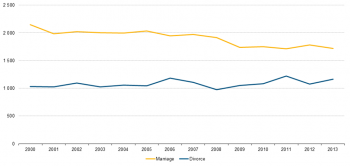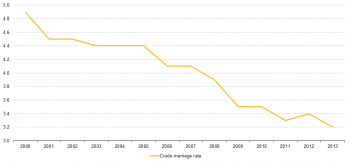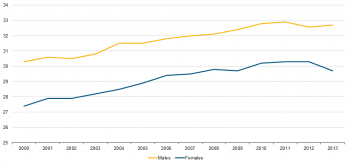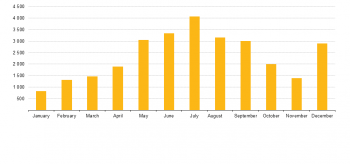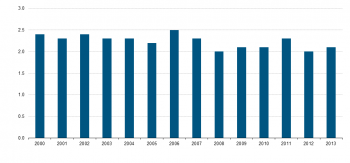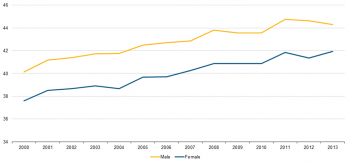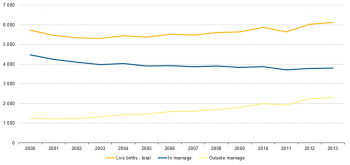- Data extracted in Month YYYY. Most recent data: Further Eurostat information, Main tables and Database. Planned article update: (dd) Month YYYY(, hh:00).
Author: STATEC – Unit “Population and Housing”
This article on marriages and births is part of a pilot project implemented by Eurostat together with nine Member States (Estonia, Spain, Latvia, Luxembourg, Croatia, the Netherlands, Romania, Slovenia and Sweden). The aim of the pilot project is to better reply to user's needs by complementing the Eurostat article presenting data on an EU level with more detailed information on the same topic, but at national level. Articles from the eight Member States are available in the corresponding national languages as well as in English and they form, together with the Eurostat article, an online publication.
This article presents the main statistical indicators on marital status, marriages, divorces and the number of births in Luxembourg between 2000 and 2013. During this period, the marriage rate in Luxembourg is continuously declining, while the age at first marriage increases. Nevertheless, more than half of adults are married or in a registered partnership. The decrease of the marriage rate does not really affect the fertility rate. Indeed, women increasingly give birth outside marriage.
Main statistical findings
Marital status of population aged 20 and over
According to the results of the general population census 2011, more than half of the population aged 20 years and over was married (56.7 %). Single people (persons never married or in a registered partnership) represented the second largest group (27.5 %) followed by divorced persons (8.6 %) and widows/widowers (7.2 %).
The part of married people or in a registered partnership decreases over time. Compared to 1981, the part of married people decreased by 12.1 %. On the other hand, the share of single and divorced people increased by respectively 9.3 % and 6.1 %.
Marital status and age are strongly correlated. According to the last census (2011), 80.5 % of persons aged 20 to 29 years were single, whereas only 6.3 % of the persons aged of 65 years and more had this marital status. The part of married people increased with age: 18.3 % aged 20 to 29 years, 63.6 % aged 30 to 49 years, and 72.5 % aged 50 to 64 years. After 65 years, the part of married people decreased (56.5 %) because an increase of the widowed people (31.2 % after 65 years) is observed.
5.4 % of the population over 20 years of age live in a consensual union
According to the 2011 census results, 21 088 people or 5.4 % of the population aged over 20 years were cohabiting as partners. In Luxembourg, consensual unions are more common among young people: 8.4 % of those aged 20 to 29 lived in a consensual union, compared to 7.7 % of those aged 30 to 49 and 2.0 % of those aged 50 and over.
Fewer marriages and age at first marriage keeps growing
The number of weddings is continuously declining passing from 2 148 marriages conducted in 2000 to 1 722 in 2013 (see Figure 2). In 2009, a decline of 9.3 % in the number of marriages was recorded compared with 2008. Since 2009, the number of marriages is relatively stable and is around 1 750 per year.
As the Luxembourg population is continuously growing the incidence of marriage is declining. As a consequence the crude marriage rate passed from 4.9 marriages for 1 000 inhabitants in 2000 to 3.2 in 2013 (1.7 marriages fewer for 1 000 inhabitants).
Apart from the decrease in the number of marriages, there is another clear trend: people marry at increasingly later ages. While the average bride and groom were 27.4 and 30.3 years old in 2000, average age at first marriage increased to 29.7 and 32.7 years by 2013. Thus, people now marry, on average, about two years and a half later than in 2000 (see Figure 4).
The number of marriages is not equally distributed over the year (see figure 5). The percentage of marriages increases from month to month and peaks in July (14.3 % of all marriages conducted in the period 2000 to 2013). The summer months (June-August) constitute the wedding season. During these three months, 37.2 % of the marriages are celebrated. The frequency of marriages during the winter months (December to February) is fairly low (17.7 %), especially in January: 2.9 % of total marriages. The increase in marriages in December, compared to the preceding month, is partly explained by the year-end holidays.
Divorces
In 2013, 1 163 marriages ended in divorce. Since the beginning of the 21st century, the number of divorces fluctuates between 977 (2008) and 1 218 (2011) divorces per year (see Figure 2).
The number of divorces per 1 000 inhabitants, that is the crude divorce rate, is relatively stable going from 2.5 in 2006 to 2.0 in 2008 and 2012 (see figure 6).
In Luxembourg, the average age at divorce is increasing during the observed period. For women, this age grows, between 2000 and 2013, from 37.6 years to 41.9 years and for men, from 40.1 years to 44.3 years (see figure 7). In fourteen years, the average age at divorce has increased by 4.3 years for women and 4.2 years for men. This growth is linked both to the increase in the average age at marriage and the increase of duration of marriage before divorce.
More and more birth outside marriage
In 2013, 6 115 children were born where the parents had their residence in Luxembourg, among which 3 129 were boys and 2 986 were girls. After a peak observed in 2000, the number of births remains relatively stable throughout period, a light decrease being observed for the years 2001 to 2003 (-7.3 %). Since 2012, however the number of live births exceeds 6 000 babies a year.
Most of the children in Luxembourg are born in the marriage. But this number is decreasing over time: 4 470 (78.1 % of the live births) in 2000 compared with 3 800 (62.1 %) in 2013. Even though it is becoming more common for children to be born outside of marriage in Luxembourg and in the rest of Europe, the share of births in the marriage is higher in Luxembourg than in the European average. Indeed, in 2012, 37.9 percent of the children born in Luxembourg had an unmarried mother, compared to 40 % in the EU. (see figure 8)
The total fertility rate describes how many children a woman is expected to have during a lifetime. It has decreased in Luxembourg during the 2000s from 1.76 in 2000 to 1.55 in 2013. Between 2000 and 2013, the lowest level was observed in 2011 with 1.52 children per women (see figure 9).
The trend in recent decades is that women in Luxembourg, as in the rest of the EU, wait longer to start a family. In 2000, the average age of being mother for the first time was 28.3 years old. In 2013, the corresponding figure increased to 30.0 years old. This is somewhat higher than the EU average of 28.7 years old (figure 10).
Due to the high level of migration in Luxembourg, the contribution of the foreign population to the number of births each year is significant. 62.6 % of children born in 2013 have a mother with a foreign citizenship. The contribution of foreign immigration to the Luxembourg population increased fertility indicators. In 2013, as in the years before, the total fertility rate for foreign women was higher than for Luxembourg: 1.80 children per foreign woman and 1.32 children per Luxembourg woman.
See also
External links
- Publications
[[Category:<statistical article>|Marriages and births in Luxembourg]] [[Category:<population>|Marriages and births in Luxembourg]] [[Category:<fertility and births>|Marriages and births in Luxembourg]] [[Category:<marriages and divorces>|Marriages and births in Luxembourg]] [[Category:<luxembourg>|Marriages and births in Luxembourg]] [[Category:<population by area and region>|Marriages and births in Luxembourg]]



